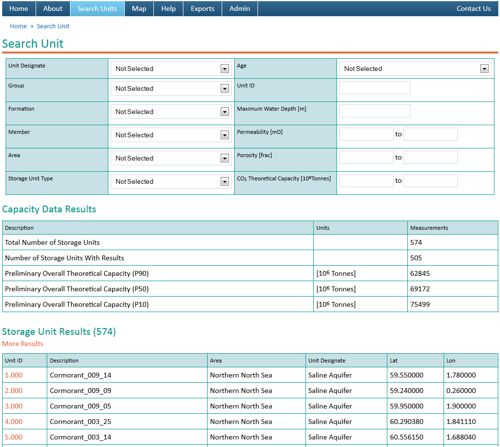Search Interface
Search for a unit
Select the 'Search Units' option from the main navigation menu.

The 'Search Unit' page will appear where you can chose from a series of search options including drop down menus for Age, Group, Permeability and so on.
As you populate the various search options the list of units under the 'Storage Units Results' section will decrease until you are left with those units that match the specifi csearch options you have chosen. The 'Search Unit' page also displays a number of overall capacity results for the search results and these are displayed under the 'Capacity Data Results' section.

From the list of matching units at the base of the page, click on the desired 'Unit ID' to enter the database pages containing information specific to that unit.
The unique ID is a number allocated to each storage unit as it is created within the database. An integer ID indicates a parent unit; daughters retain the corresponding integer part of the ID number, and the decimal part is used to distinguish between individual daughters of the same parent. The parent might, for example, be one part of an extensive formation, which has been identified as a separate storage unit because it has a representative reservoir pressure that is distinct from other parts of that formation. The daughters might then be each of the identified hydrocarbon fields associated with that parent. Thus:
The ID number itself has no significance other than to provide a means of cross-referencing information within the relational database. They are not necessarily continuous, nor should anything be inferred about the geographical location of units with either similar, or very different, storage unit IDs.
Overall Capacity
The Overall Theoretical Capacity is displayed under the 'Capacity Data Results' section of the 'Search Units' page. The Overall Theoretical Capacity is the summed theoretical storage capacity (P90, P50, P10) of all units returned by the search.

The summed P90, P50, P10 capacities of searched units is calculated on the assumption that the sum of many distributions, irrespective of their individual skewness, approximates a normal distribution. However, the lower the number of combined distributions, the greater the degree of this approximation. Summed capacities are hence described as preliminary; if individual storage unit capacity distributions were exported from the database and combined rigorously (for example using Monte Carlo simulation), more accurate estimates of the overall P90 and P10 capacity would be achieved.







